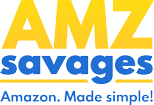The great dichotomy of being an ecommerce seller is that you spend the first portion of your journey trying to drive all of your traffic to Amazon. The second portion you spend trying to drive sales off Amazon and funnel them to your personal website. When online retailers get to a good point where they’ve mastered scalability, revenue stream, and operations, most will end up selling their products on multiple platforms.
But why are most entrepreneurs hell bent on utilizing Amazon as their first resource? The reasons are fairly obvious. For one, Amazon has the highest amount of traffic, accounting for almost 50% of all online purchases. Following up with that unprecedented metric is the fact that FBA allows for convenient and controlled storage, shipping, and handling.
Conversely, Amazon does take a significant amount of profit for all of these services. Coupled with their notoriously bad customer service and continually changing TOS, many sellers find themselves in a tough spot; they need Amazon’s traction but can’t afford their services and PPC costs. This is when merchants start trying to sell their products on their own site, provided they have a decent customer base established.
But if Amazon truly is an “evil necessity” for ecom sellers to make earnings, what options do they have to drive traffic to their listing? While PPC has been the main focal point for many Amazon sellers, the advertising platform has become increasingly difficult to both pay for and achieve results.
Why Has Amazon Sponsored Ads Become Expensive?
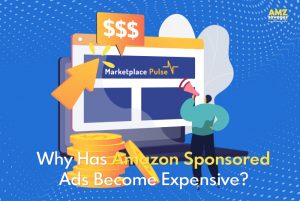
In recent months, PPC has increased (on average) to $1.20 per click. This is an uptick of 30% from $0.93 at the start of 2021 and up over 50%, year-over-year. Demand for advertising and coveted placements is rising faster than the ad availability on the platform, creating an inundation of advertisements and driving up advertising prices.
According to this article by Marketplace Pulse, the average cost-per-click (CPC) was $0.85 in 2020. It reached the lowest point of $0.70 in early May of 2020 when COVID caused supply chain disruptions, making inventory availability impossible for many retailers which caused them to pause running ads. Rounding into Q1 of 2021, the average cost per click exceeded $0.90.
The average ACoS for most retailers in 2020 hovered around 22%, rising to 25% in the first 2 quarters of 2021. The average advertising cost of sale (ACoS) was 22% in 2020. It has now risen upward of 30%., not taking into account brand new sellers whose ACoS typically is significantly higher due to low sales and reviews.
To make matters worse for SMBs, larger players with deeper pockets have started taking over the ever-popular marketplace, bringing with them insatiable advertising spends. As a result, they can afford to compete for more ad space AND afford higher bids.
The Surge of Aggregators has Influenced Ad Spend
With the recent trend of M&As and aggregators taking on Amazon’s potential, there is no doubt that their existence has inadvertently driven up CPC values. According to Nozzle, “Sellers that choose to independently run their Amazon brands face massive competition from brands operating via Amazon Aggregators. These companies have huge funding which means they can scale more quickly due to increased investment in that brand.”
And a lot of that funding allows acquisition firms to stream exorbitant amounts of money into Amazon advertising. In turn, their ability to achieve better ad placement increases public brand awareness as well as organic ranking, perpetuating an even larger profit gap between SMBs and M&As.
Other Than PPC Spend, What are the Advantages of Using External Traffic to Drive Amazon Sells?
While you will probably always have to run PPC on your products, there are advantages to using omni channel funnels to encourage sales on the Amazon marketplace.
1. Access to More Potential Customers
By utilizing channels outside of Amazon to drive traffic to your product listings, you are expanding your pool of potential customers. It’s important to remember that Amazon is an end-of-the-funnel shop. That means that people go to Amazon to look for something in particular. Sure, there’s such a thing as browsing and “window shopping”, but even then, customers go to the site and type in keywords to find products.
So, if you have a unique and new product that nobody has ever heard of or doesn’t know how to search for, your chances of success are pretty slim.
If, however, you utilize Facebook, Pinterest, IG, or other social media channels to bring awareness to your product, you can then send potential buyers straight to your Amazon store.
2. You Have an Advantage Over Your Competitors
As mentioned above, selling on Amazon is becoming exceedingly competitive. By driving external traffic to Amazon, you gain an advantage over competitors, circumventing sponsored ads and competitors among your SERPs.
This method, however, isn’t recommended for brand new sellers whose main objective is trying to achieve ranking via their target keywords because it bypasses the use of a customer typing in keywords to find your product. Of course, you can always use a 2-step URL code which integrates your coveted keywords into the URL, thus making Amazon “think” someone went through the process of Search-Find-Buy. However, these links are not nearly as powerful as they used to be and studies show that real SFB is the best means of ranking your listing.
3. Increases brand awareness
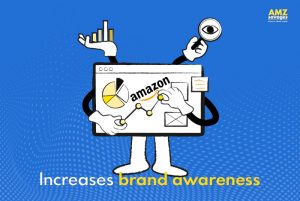
Another effective way sellers thrive and survive on Amazon is with their strong, distinguishable brand; something special and/or unique that separates them from others.
However, the hitch here is that Amazon gives fewer opportunities to achieve this on it’s actual platform due to the magnitude of sponsored ad displays, competitors, and rules that set pretty restrictive parameters. .
Advertising outside Amazon allows you more creativity and the ability to capitalize on your brand’s voice. Turn memorable content into something the viewers won’t forget.
Once you’ve established the value of your brand and products, customers will become more engaged and go to Amazon strictly to find your product.
4. Diversify for More Sales Opportunities
As mentioned before, utilizing social media to bring awareness to your brand is incredibly effective (provided you do it correctly). This is efficient whether you are a newbie seller or a veteran.
Rather than depending on Amazon solely, external traffic paves the way for you to take control. By mastering the various ways to drive traffic to Amazon listings, you’ll have successful launches, boost your sales, and have a long-term relationship with your customers.
Applying the right Amazon SEO strategies and achieving sales through PPC makes sense. However, know that when the customers purchase your product on Amazon, they are not your customers. Instead, they are Amazon’s customers. It isn’t until you are able to achieve brand awareness that you can start redirecting your omni channel advertising to your own website, thus making them YOUR customers – not Amazon’s.
In order to be successful, it is vital to have a sustainable business model. You’re not just there to sell products; your goal should be to build a powerful brand that resonates with customers that hopefully will become loyal buyers. This can only be possible if you leverage external mediums.
5. Amazon Encourages Outside Traffic
Intuitively, this doesn’t really make sense. Sure, they end up getting the sale, so they should be happy no matter how the shopper made it to the platform. However, it also means a loss of PPC spend which is a big money-maker for the conglomerate.
One of the suggested advantages for Amazon is that they can keep track of omnichannel sales and both buyer and seller behavior. Months ago, when Amazon imposed strict restock inventory restrictions, this caused many Amazon sellers to start selling products on other channels. Realizing that they no longer had control over the metrics of sales on multiple platforms, Amazon almost immediately raised restock inventory limits.
So What Are Some Effective Uses of Outside Traffic?
Let’s be real: there are a million different ways you can promote your brand and products – from common sources like Facebook and Instagram to more newly-established platforms like Reddit and TikTok. Even advertising on other websites, blogs, and articles is a creative and good way to expand your reach. For example: If you are selling reusable baby diapers, there’s no reason you can’t search for the top ranked mommy blog sites and advertise there. There really is an endless supply of possibilities so long as you know where to look and how to purpose them correctly.
Build an Email List
An email list is one of the most important brand assets for an online business. Yet, you’re not able to collect emails selling only on Amazon.
Amazon protects its customers’ details. Any attempt to get your Amazon customers’ real email addresses will put you in violation of their Terms of Service.
However, the key distinction is whether you make contact before or after they get to Amazon.
If you make contact with customers prior to their purchase on Amazon, it’s fair game to capture their contact details.
With a customer list, you have so many more possibilities to grow your brand. You can:
- run marketing campaigns
- push cross-sells and up-sells
- build long-term relationships with your customers
- launch products for much lower costs
- create newsletters to inform your clients of new products and sales
Additionally, your list gives you a fallback plan if you find yourself unable to sell on Amazon in the future. Whether because of a TOS violation, black-hat tactics from other sellers, or just a desire to have more control and sell on your own site, collecting leads is like building a community and the more you nourish that community, the more it will grow and remain loyal.
Utilize Facebook Messenger and Chatbots for Sales Conversions
While email has long been the go-to for building customer communication, Facebook Messenger and chatbots have become effective and popular in their own right.
With much better open rates and engagement rates, Messenger is proving an even more effective marketing channel for many online stores, particularly for reaching promotions and deals. Just be uber careful not to incentivize others for reviews. While it hasn’t been officially established, there is probable evidence to suggest that Amazon can follow fake or incentivized reviews and label them unverified based on the inundation of sellers’ use of Facebook to launch their products.
Chatbots like ManyChat are also widely popular among Amazon sellers to emulate SFB and to try and offer discounts in exchange for reviews. While many merchants have found this tool to be incredibly useful (particularly during launch), people speculate that Amazon (at some point) will completely shut down reviews coming from bot systems.
Steps To Take To Make Sure You’re Not Wasting Your Time Utilizing Outside Sources
There’s no doubt driving traffic can be beneficial for your Amazon store, but if your listing isn’t set up properly, then all your hard work is null-and-void. It’s kind of like having billboards and road signs to your shop. Sure, you can direct a lot of people TO your store, but if the inside looks like crap, nobody is going to buy anything. So, it’s a lot of time wasted.
Here are the key steps to ensure the biggest return from Off-Amazon traffic.
Before you start: MAKE SURE YOUR LISTING IS WELL OPTIMIZED. External traffic doesn’t make up for a poor product listing. If your listing is a hodge-podge of keyword stuffing, unpersuasive sales copy, and poor images, nobody is going to purchase your products – no matter how great your Facebook ads looked.
Choosing the Right Advertising Channel For Your FBA Business
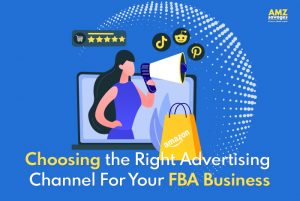
Once your listing is primed to send traffic to, you need to figure out where it’s going to come from.
Not all traffic sources are created equal. That doesn’t mean they aren’t all effective in their own right; it means that you have to choose your advertising source based on your product. For example, if you sell baby items or arts & crafts, great options for YOU may be Instagram and Pinterest. If you sell electronics and gadgets, maybe Reddit is a great source. If you sell makeup, TikTok might be the right option for your brand.
Facebook has the largest audience base. However, Facebook Ads are getting more competitive and expensive, so nailing your targeting, ad copy, and creatives is a must.
Influencer Marketing is another powerful way to drive traffic. Find people related to your niche who already have an engaged audience, and partner with them to promote your products. Amazon even has their own program to connect brands with influencers as does TikTok.
Other channels you might want to test include:
- Google Ads (formerly AdWords)
- YouTube
- Blogs & Google SEO
Don’t Send Traffic Directly to Your Listing
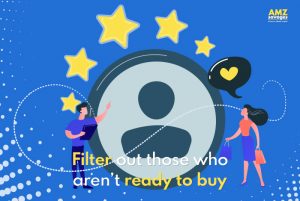
Once you’ve settled on your traffic channels, don’t fall into the same trap that many sellers do.
If you send traffic straight to your product listing, you miss out on a lot of the benefits of external traffic. You even risk hurting your Amazon keyword rankings, too.
As mentioned earlier in this post, one of the best reasons to drive your own traffic is that it allows you to build a customer list. But if you send people straight from external channels to your listing, you’ve missed this opportunity.
Say you’re running ads on Facebook. You link your ad to Amazon. Someone clicks through, but you haven’t captured an email or Messenger subscription. If you try to get their contact details after the fact, you’ll be in violation of Amazon’s terms, since they’re now an Amazon customer.
This can also cause damage to your conversion rate. But why?
Comparing Conversion Rates On & Off Amazon
Average conversion rates on Amazon are very good. Around 13% for regular Amazon customers and over 70% for Amazon Prime members.
In comparison, the average e-commerce conversion rate across all platforms hovers around 3%.
This goes back to Amazon being an end-of-the-funnel shop. Customers on Amazon are there because they’re looking for a product. Thus, buying intent is at its highest.
In comparison, people in other channels often aren’t in the same “buy now” mode. Even if they are interested in what you have for sale, many aren’t ready to buy just yet. Say you are running ads on IG and one of your videos captures a handful of potential customers. You’ve piqued their interest but not their need to purchase immediately, as a significant amount of IG users don’t utilize that platform for shop. Often, they’ll click through to your listing to see what your product is all about but still bounce without buying. At this point, they are in research mode, not buying mode.
With conversion rate being a big part of the Amazon search algorithm, sending a lot of non-converting traffic to your listing can easily tank your search rankings, and put you worse off than when you started. This is because Amazon views your listing as a failure. If you have tons of people going to your listing but no one actually purchases your product, your ranking will go down.
The solution? Drive traffic to a landing page, or similar sales funnel first so that you still generate leads to interested customers. You can then use these emails to reach out to interested customers via newsletters or dedicated emails that highlight discounts, new products, or any exciting news about your brand and/or product
Sales funnels for external traffic
The quality of your sales funnel is a big factor in whether you achieve significant results via the traffic you drive.
A proper funnel will:
- Qualify your traffic
- Filter out those who aren’t ready to buy
- Allow you to retarget
- Capture contact details
- (Optional) send an incentive for people to buy
For example, you can utilize Facebook messenger or a chatbot flow to achieve all of this. Your customer can click on your facebook ad which sends them through your bot (not directly to Amazon right away). Via their communication with the bot on messenger, you can capture their information on your messenger list so you can build a relationship with potential clients that can be used in the future for new products or to promote the ones you already have,
Summary
As more competition joins Amazon, third-party sellers need more unique ways to achieve rank, sales, reviews, and brand recognition. This is no easy feat particularly when in 2021 alone, Amazon gained 469,000 new merchants.
Omni channel marketing that extends beyond PPC helps with: lowering your PPC spend, creating brand awareness, expanding your audience, targeting certain demographics, achieving magnet leads, and increasing sales on your Amazon store.
As the marketplace behemoth continues to grow, it’s your responsibility to come up with granular marketing strategies and streamlined funnels if you want to succeed on Amazon.
